Exhibition dates: 8th March 2019 – 13th April 2020
Italy, Venice (manufacturer)
Bowl
c. 1736
Glass (latticinio)
6.1 x 12.0cm diameter
National Gallery of Victoria, Melbourne Purchased, 1871
I love art glass, glass art: either old or contemporary, Italian, Scandinavian or Australian, it doesn’t matter. I have a collection of contemporary art glass myself. This love of glass comes from my parents who took us kids to see glass blowing on the island of Mallorca when we were growing up. Our house had numerous pieces of beautiful mouth blown glass brought back from the Balearic Islands.
My favourite period for Italian glass is the 1960s. My favourite techniques are the use of ‘millefiori’ (the production of glass canes or rods, known as ‘murrine’, with multicoloured patterns which are viewable only from the cut ends of the cane), latticinio (which resembles lace) and vetro a retorti (twisted glass). Venetian mirrors and chandeliers are another love: imagine them twinkling in the candlelight when there was no electricity!
Glass is such a malleable medium. The results can look effortless, sublime… but only after years of experience and experimentation by the artist. The delicacy, colour, iridescence, form and strength (of purpose) of glass is mesmerising. Words are not enough.
Dr Marcus Bunyan
Many thankx to the National Gallery of Victoria for allowing me to publish the photographs in the posting. Please click on the photographs for a larger version of the image.
Italy, Venice / Spain (manufacturer)
Jug
Mid 16th century
Glass (vetro a retorti decoration)
16.6 x 14.2 x 9.4cm
National Gallery of Victoria, Melbourne
Purchased through The Art Foundation of Victoria with the assistance of Mrs Margaret Stewart, Founder Benefactor, 1987
Italy, Venice (manufacturer)
Oil and vinegar cruet
c. 1680
Glass (applied decoration)
23.0 x 11.3 x 9.5cm
National Gallery of Victoria, Melbourne William and Margaret Morgan Endowment, 1973
Installation view of Serpent-stem goblet (Flügelglas), (early 17th century), The Netherlands, Holland / Germany (manufacturer) on display as part of Liquid Light: 500 Years of Venetian Glass at NGV International from 8 March 2018 – 13 April 2020
Photo: Tom Ross
The Netherlands, Holland / Germany
Serpent-stem goblet (Flügelglas)
Early 17th century
Glass (façon de Venise), (red and white threads, applied and pincered decoration)
28.3 x 10.0cm diameter
Felton Bequest, 1977
Photo: Victoria Zschommler
Italy, Venice (manufacturer)
Tazza
18th century
Glass
2.3 x 17.1cm diameter
National Gallery of Victoria, Melbourne Purchased, 1871
Installation view of Tazza, 18th century, Italy, Venice (manufacturer) on display as part of Liquid Light: 500 Years of Venetian Glass at NGV International from 8 March 2018 – 13 April 2020
Photo: Tom Ross
Left to right
Giuseppe Briati (Italian 1686-1772) (manufacturer)
Bowl
c. 1736
Glass (latticinio)
6.1 x 12.0cm diameter
Purchased, 1871
Italy, Venice
Decanter
c. 1800
Glass
(a-b) 36.5 x 7.3cm diameter (overall)
Purchased, 1919
Venice and Murano Glass and Mosaic Company, Venice (manufacturer) Italian est. 1859
Wine glass
c. 1880
Glass
16.5 x 6.9cm diameter
Photo: Victoria Zschommler
Italy, Venice (manufacturer)
Vase
18th century
Glass
14.9 x 11.6 x 8.0cm
National Gallery of Victoria, Melbourne Purchased, 1871
Clockwise from left
Italy, Venice
Vase
18th century
Glass
14.9 x 11.6 x 8.0cm
Purchased, 1871
Italy, Venice
Covered bowl
18th century
Glass
(a-b) 14.2 x 13.2 x 12.0cm (overall)
Purchased, 1871
Italy, Venice
Goblet
c. 1794
Glass, silver
12.0 x 10.7cm diameter
Purchased, 1871
Photo: Victoria Zschommler
Italy, Venice (manufacturer)
Beaker
Late 18th century
Glass (enamel, gilt)
10.5 x 8.0cm diameter
National Gallery of Victoria, Melbourne Purchased, 1871
Italy, Venice (manufacturer)
Covered bowl and stand
Late 18th century
Glass (applied decoration)
(a-c) 14.0 x 15.2cm diameter (overall)
National Gallery of Victoria, Melbourne Purchased, 1871
Venice And Murano Glass And Mosaic Company, Venice (manufacturer) Italy est. 1859
Ewer
c. 1870
Glass
15.9 x 6.6 x 6.1cm
National Gallery of Victoria, Melbourne Purchased, 1874
Venice And Murano Glass And Mosaic Company, Venice (manufacturer) Italy est. 1859
Goblet
c. 1878
Glass
17.4 x 9.9cm diameter
National Gallery of Victoria, Melbourne Purchased, 1881
Venice And Murano Glass And Mosaic Company, Venice (manufacturer) Italy est. 1859
Decanter
c. 1880
Glass
(a-b) 23.6 x 12.9 x 11.2cm (overall)
National Gallery of Victoria, Melbourne Purchased, 1881
Installation view of Tazza, 18th century, Italy, Venice (manufacturer) on display as part of Liquid Light: 500 Years of Venetian Glass at NGV International from 8 March 2018 – 13 April 2020
Photo: Tom Ross
Venice and Murano Glass and Mosaic Company, Venice (manufacturer) Italy est. 1859
Ewer
c. 1880
Glass
24.7 x 12.1 x 9.9cm
National Gallery of Victoria, Melbourne Gift of John H. Connell, 1914
Venice And Murano Glass And Mosaic Company, Venice (manufacturer) Italy est. 1859
Jug
c. 1880
Glass
27.2 x 13.3 x 10.7cm
National Gallery of Victoria, Melbourne Gift of John H. Connell, 1914
Venetian glass is famous throughout the world for its vibrant colour and crystalline clarity, elaborate design and unmatched craftsmanship, honed over hundreds of years by local artisans on the island of Murano in Venice, Italy.
Liquid Light: 500 Years of Venetian Glass draws upon the National Gallery of Victoria’s extensive holdings of Venetian glass, ranging in date from the sixteenth to the twentieth century, including the NGV’s especially rich material from the nineteenth-century revival period.
In displays exploiting the characteristic brilliance and vivid colour palette of Murano glass, the exhibition traverses five centuries of style – from Baroque to post-modernism – through a display of glassware, including elaborate champagne flutes and goblets, bowls and vases, tableware and decorative objects.
Highlights from the exhibition include an opulent Serpent-stem goblet from the early seventeenth century, replete with intertwining dragons that coil around its stem, and a bottle-shaped Patchwork vase by Fulvio Bianconi, c. 1950, created by masterfully fusing blocks of coloured glass into a kaleidoscope of colour.
The exhibition will showcase the Venetians’ technical prowess through considered displays of the famous cristallo body, known for its transparent, watery fineness, as well as lattimo, a milky, white glass coveted for its resemblance to porcelain, and vetro a filigrana – glasses decorated with fine white threads twisted into elaborate patterns.
Though the secret formula for Venetian glass was heavily guarded on Murano, its qualities were emulated by major European glasshouses, particularly in the Netherlands. Through exquisite displays of ‘façon de Venise’ glass, the exhibition will celebrate the indelible impact and legacy of Venetian glass on glassblowing world-wide.
Venetian glass experienced a major revival in the nineteenth-century as Venice became part of the newly unified Kingdom of Italy. The unification sparked the restoration of traditional Italian industries, including the Muranese glass industry, which enjoyed a resurgence in connoisseurship and supremacy.
In 1871 a large collection of Venetian glass was acquired by the NGV directly from Venice by the proconsul to the Kingdom of Italy, and a further group of works was acquired in 1874, from the manufactory of Antonio Salviati, the father of the Venetian glass revival. Further important groups of nineteenth-century Venetian glass entered the Collection from the Italian displays at the 1880-81 Melbourne International Exhibition.
Tony Ellwood AM, Director, NGV said, ‘The first examples of Venetian glass entered the NGV Collection nearly 150 years ago. This exhibition will celebrate not only the breadth and beauty of the glassware in the NGV Collection, but also the rich legacy of the art form from the sixteenth century to today.’
Press release from the National Gallery of Victoria [Online] Cited 13/02/2020
Venice and Murano Glass and Mosaic Company, Venice (manufacturer) Italy est. 1859
Chalice
c. 1880
Glass (pincered and applied decoration)
30.0 x 10.3cm diameter
National Gallery of Victoria, Melbourne Purchased, 1881
Venice And Murano Glass And Mosaic Company, Venice (manufacturer) Italy est. 1859
Kuttrolf
c. 1880
Glass
21.6 x 10.9cm diameter
National Gallery of Victoria, Melbourne Purchased, 1881
Installation view of Kuttrolf, c. 1880, Venice and Murano Glass and Mosaic Company, Venice (manufacturer) on display as part of Liquid Light: 500 Years of Venetian Glass at NGV International from 8 March 2018 – 13 April 2020
Photo: Tom Ross
Venice And Murano Glass And Mosaic Company, Venice (manufacturer) Italy est. 1859
Goblet
c. 1880
Glass
23.2 x 14.1 x 7.6cm
National Gallery of Victoria, Melbourne Gift of John H. Connell, 1914
Installation view of Liquid Light: 500 Years of Venetian Glass on display at NGV International from 8 March 2018 – 13 April 2020 showing at centre, Goblet c. 1880 by the Venice And Murano Glass And Mosaic Company, Venice
Photo: Tom Ross
Venice and Murano Glass and Mosaic Company, Venice (manufacturer) Italy, est. 1859
Covered goblet
c. 1880
Glass
(a-b) 29.1 x 15.4 x 10.8cm (overall)
National Gallery of Victoria, Melbourne Purchased, 1881
Left to right
Venice and Murano Glass and Mosaic Company, Venice (manufacturer) Italian est. 1859
Covered goblet
c. 1880
Glass
(a-b) 29.1 x 15.4 x 10.8cm (overall)
Purchased, 1881
Venice and Murano Glass and Mosaic Company, Venice (manufacturer) Italian est. 1859
Goblet
c. 1880
Glass
18.3 x 12.0cm diameter
Purchased, 1881
Venice and Murano Glass and Mosaic Company, Venice (manufacturer) Italian est. 1859
Wine glass
c. 1880
Glass (blown, applied decoration)
11.7 x 6.8 x 5.9cm
Purchased, 1881
Photo: Victoria Zschommler
Vetreria Fratelli Toso, Murano, Venice (attributed to) (manufacturer) Italy 1854-1901
Vase
c. 1890-1900
Glass (murrine decoration)
25.5 x 19.7 x 15.1cm
National Gallery of Victoria, Melbourne Purchased, 1996
Millefiori
Millefiori is a glasswork technique which produces distinctive decorative patterns on glassware. The term millefiori is a combination of the Italian words “mille” (thousand) and “fiori” (flowers). Apsley Pellatt in his book Curiosities of Glass Making was the first to use the term “millefiori”, which appeared in the Oxford English Dictionary in 1849; prior to that, the beads were called mosaic beads. While the use of this technique long precedes the term “millefiori”, it is now most frequently associated with Venetian glassware.
The manufacture of mosaic beads can be traced to Ancient Roman, Phoenician and Alexandrian times. Canes, probably made in Italy, have been found as far away as 8th century archaeological sites in Ireland. Millefiori beads have been uncovered from digs at Sandby borg, Öland, Sweden, dating apparently from the late 5th or early 6th century. A piece of millefiori was found, along with unworked garnets, in a purse at the early 7th century Anglo-Saxon burial site at Sutton Hoo.
The technical knowledge for creating millefiori was lost by the eighteenth century, and the technique was not revived until the nineteenth century. Within several years of the technique’s rediscovery, factories in Italy, France and England were manufacturing millefiori canes. They were often incorporated into fine glass art paperweights.
Until the 15th century, Murano glass makers were only producing drawn Rosetta beads made from moulded Rosetta canes. Rosetta beads are made by the layering of a variable number of layers of glass of various colours in a mould, and by pulling the soft glass from both ends until the cane has reached the desired thickness. It is then cut into short segments for further processing.
The millefiori technique involves the production of glass canes or rods, known as murrine, with multicoloured patterns which are viewable only from the cut ends of the cane. A murrine rod is heated in a furnace and pulled until thin while still maintaining the cross section’s design. It is then cut into beads or discs when cooled.
Text from the Wikipedia website
Installation view of Liquid Light: 500 Years of Venetian Glass on display at NGV International from 8 March 2018 – 13 April 2020 showing at left in the bottom image, Goblet c. 1878 by the Venice and Murano Glass and Mosaic Company, Venice
Photo: Tom Ross
Venice and Murano Glass and Mosaic Company, Venice (manufacturer) Italian est. 1859
Goblet
c. 1878
Glass
15.1 x 14.1cm diameter
Purchased, 1881
Photo: Victoria Zschommler
Installation view of Liquid Light: 500 Years of Venetian Glass on display at NGV International from 8 March 2018 – 13 April 2020
Photo: Tom Ross
Installation view of Candelabrum, c. 1880, Venice and Murano Glass and Mosaic Company, Venice (manufacturer) on display as part of Liquid Light: 500 Years of Venetian Glass at NGV International from 8 March 2018 – 13 April 2020
Photo: Tom Ross
Installation view of Liquid Light: 500 Years of Venetian Glass on display at NGV International from 8 March 2018 – 13 April 2020
Photo: Tom Ross
Installation view of Tazza, c. 1880, Venice and Murano Glass and Mosaic Company, Venice (manufacturer) on display as part of Liquid Light: 500 Years of Venetian Glass at NGV International from 8 March 2018 – 13 April 2020. Photo: Tom Ross
Venice and Murano Glass and Mosaic Company, Venice (manufacturer) Italian est. 1859
Tazza
c. 1880
Glass (applied decoration)
23.4 x 22.3cm diameter
Purchased, 1881
Photo: Victoria Zschommler
Left to right
Venice and Murano Glass and Mosaic Company, Venice (manufacturer) Italian est. 1859
Ewer
c. 1880
Glass (blown, applied decoration)
25.8 x 9.9 x 9.2cm
Purchased, 1881
Venice and Murano Glass and Mosaic Company, Venice (manufacturer) Italian est. 1859
Ewer
c. 1880
Glass (blown, applied decoration)
26.0 x 9.7cm diamater
Purchased, 1881
Photo: Victoria Zschommler
Left to right
Venice and Murano Glass and Mosaic Company, Venice (manufacturer) Italian est. 1859
Goblet
c. 1870
Glass
14.1 x 10.2 x 9.4cm
Purchased, 1881
Venice and Murano Glass and Mosaic Company, Venice (manufacturer) Italian est. 1859
Goblet
c. 1880
Glass (pincered and applied decoration)
28.7 x 9.9cm diameter
Purchased, 1881
Photo: Victoria Zschommler
Clockwise from left
Venice and Murano Glass and Mosaic Company, Venice (manufacturer) Italian est. 1859
Tazza
c. 1880
Glass
11.9 x 14.2cm diameter
Purchased, 1881
Venice and Murano Glass and Mosaic Company, Venice (manufacturer) Italian est. 1859
Goblet
c. 1878
Glass
19.7 x 12.4cm diameter
Purchased, 1881
Venice and Murano Glass and Mosaic Company, Venice (manufacturer) Italian est. 1859
Vase
c. 1880
Glass
13.2 x 8.8 x 7.9cm
Purchased, 1881
Photo: Victoria Zschommler
Venice and Murano Glass and Mosaic Company, Venice (manufacturer) Italian est. 1859
Bottle
c. 1878
Glass
(a-b) 16.0 x 13.1 x 11.8cm (overall)
Purchased, 1881
Photo: Victoria Zschommler
Venini & Co., Murano (manufacturer) Italy est. 1921
Fulvio Bianconi (designer) (Italy 1915-96)
Handkerchief (Fazzoletto) vase
1949 designed, c. 1950-60 manufactured
Glass (vetro a fili decoration)
19.8 x 34.0 x 21.7cm
National Gallery of Victoria, Melbourne Purchased from Admission Funds, 1989
Clockwise from right
Vetreria Fratelli Toso, Murano, Venice (Italian 1854-1901) (manufacturer)
Vase
c. 1890-1900
Glass (murrine decoration)
25.5 x 19.7 x 15.1cm
Purchased, 1996
Richard Marquis (American born 1945) (designer)
Non-functional teapot
1976
Glass (murrini (mosaic) decoration, applied decoration)
8.6 x 15.8 x 12.6cm
Presented through The Art Foundation of Victoria by Terence Lane, Fellow, 1996
Venini & Co., Murano (Italian est. 1921) (manufacturer)
Fulvio Bianconi (Italian 1915-1996) (designer)
Patchwork (Pezzato) vase
c. 1950
Glass
36.6 x 14.6 x 10.9cm
Felton Bequest, 1952
Photo: Victoria Zschomm
Venini & Co., Murano (manufacturer) Italy est. 1921
Fulvio Bianconi (designer) (Italy, 1915-96)
Patchwork (Pezzato) vase
c. 1950
Glass
36.6 x 14.6 x 10.9cm
National Gallery of Victoria, Melbourne Felton Bequest, 1952
Installation view of Liquid Light: 500 Years of Venetian Glass on display at NGV International from 8 March 2018 – 13 April 2020
Photo: Tom Ross
NGV International
180 St Kilda Rd, Melbourne
Opening hours:
Open daily, 10am – 5pm

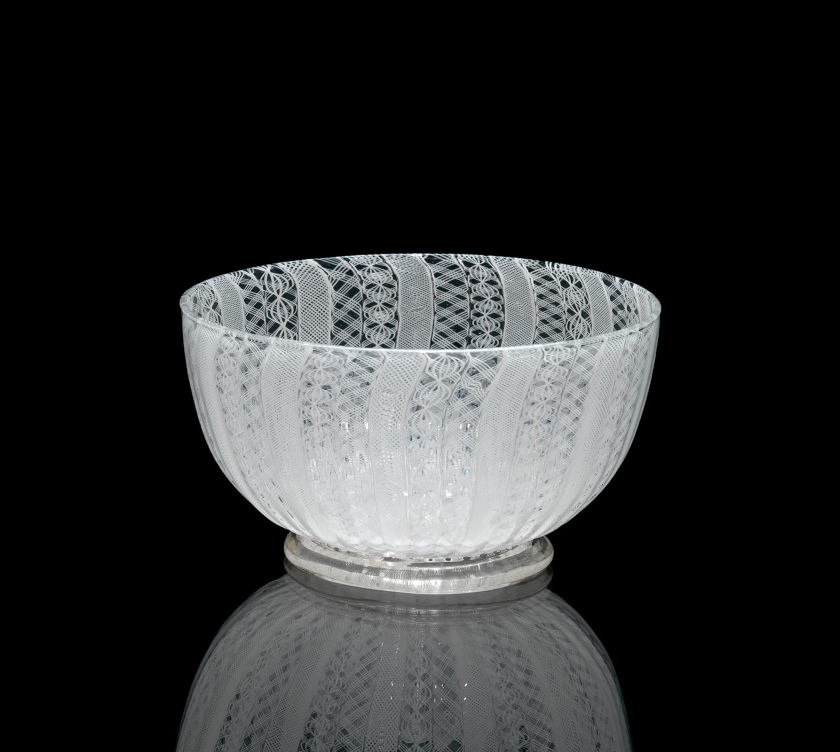




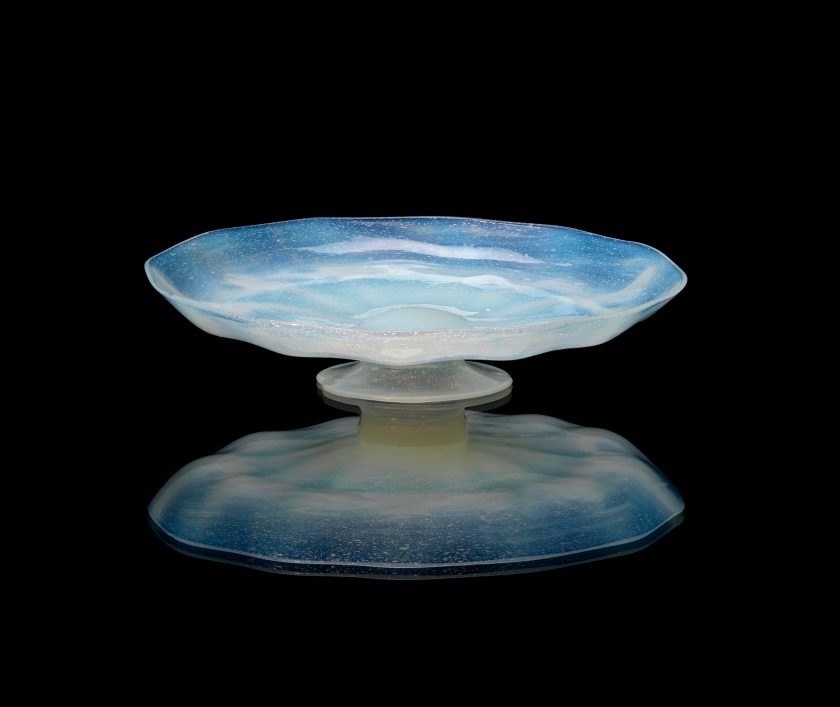
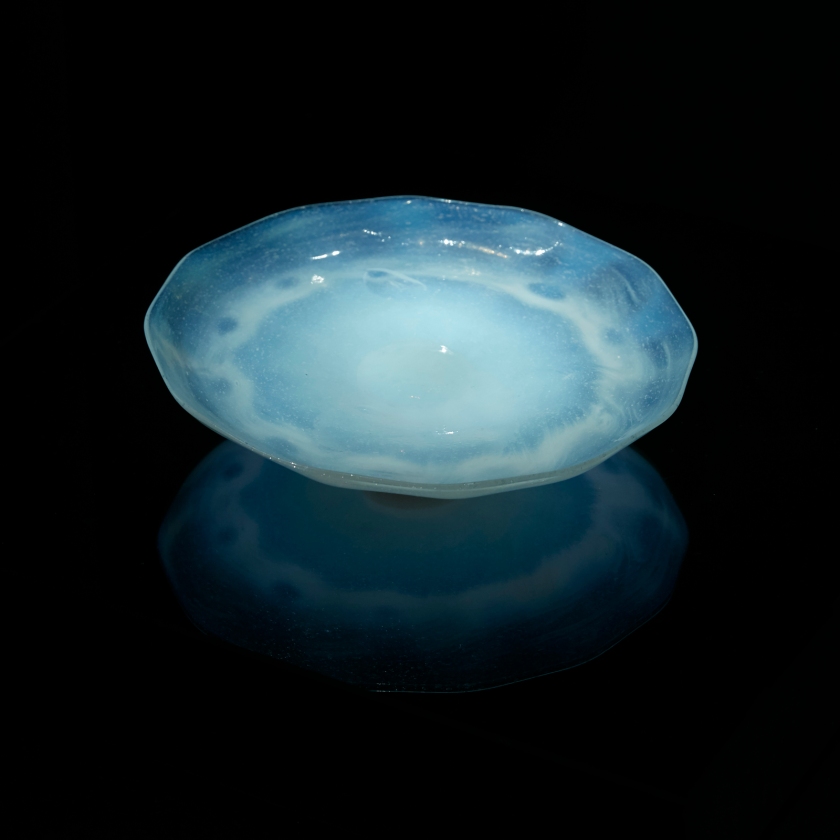
















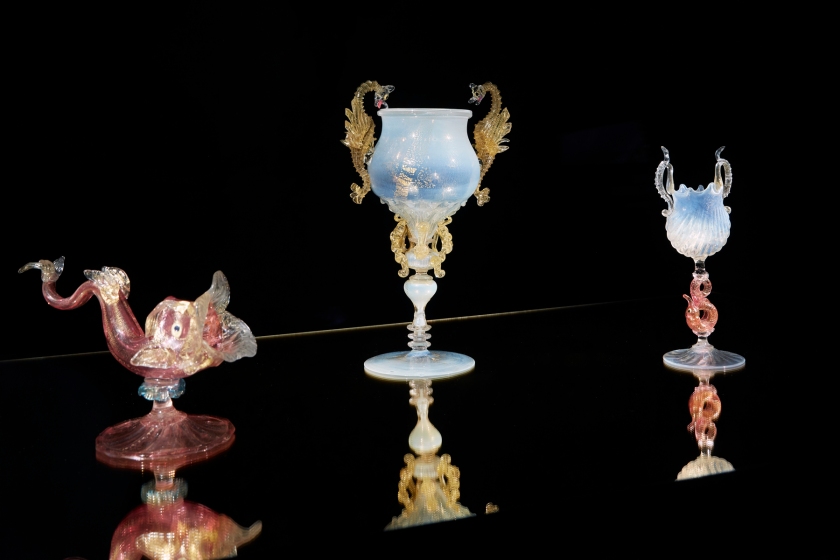












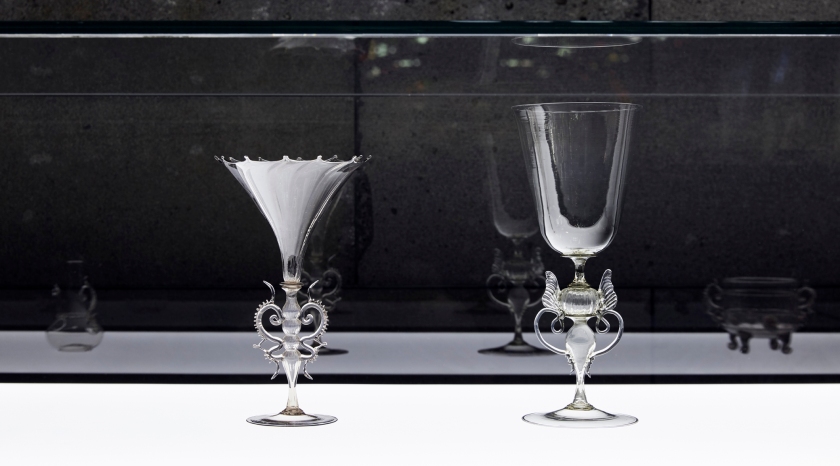












You must be logged in to post a comment.